
Disclaimer: This blog entry wasn’t written until seven years after the trip. It should be noted that this was a huge mistake. Sometimes after writing so much about other days, it happens that at the time directly after the trip or even during, I convince myself that the details are not that important. Years later, these details are that important, and pulling them out of foggy memories is difficult. The photos help and often leave clues, and then Caroline’s memories are usually far clearer than mine. With that said, here goes.
The Dresden Frauenkirche, or Church of Our Lady, is a Lutheran place of worship. Hence, the statue of Martin Luther standing in front of it. Back in 1995, when Caroline and I were moving to the States from Germany, reconstruction of the Frauenkirche had just begun. For fifty years after World War II, it sat as a sad ruin in total destruction. Even this statue of Martin Luther was toppled in the mayhem that devastated Dresden, but it survived and was repaired long before the church. Only eight years ago, the reconstructed building was once again standing in the glory of its best days. This being a Protestant church, they are open when it suits them, so as we wait for a visit to this significant sight, we’re off to the Catholic church, which is almost always open.

This is the Fürstenzug mural featuring a procession of the rulers of Saxony. A week ago, when Caroline and I were up north near the Wattenmeer, she told me the story of the Frisians of Saxony and how, back in the 5th century AD, they inhabited parts of Britain after Rome fell. With their Celtic roots now merged with some German ancestry, things would remain relatively calm for almost 600 years until the Norman Conquest pumped England and the evolving English language full of French. As the British Empire rose, I don’t think we can divorce the influence of Rome, Germany, and France on this little island nation and realize that the beginning of multiculturalism is quite old and didn’t just arrive with late 20th-century liberalism. Back to the Fürstenzug that we are walking along, originally, this “Procession of Princes” was painted between 1871 and 1876 to celebrate the 800th anniversary of the Wettin Dynasty. One hundred years ago, the painting was replaced with 23,000 pieces of porcelain, making this 335-foot-long mural the largest porcelain artwork in the world.
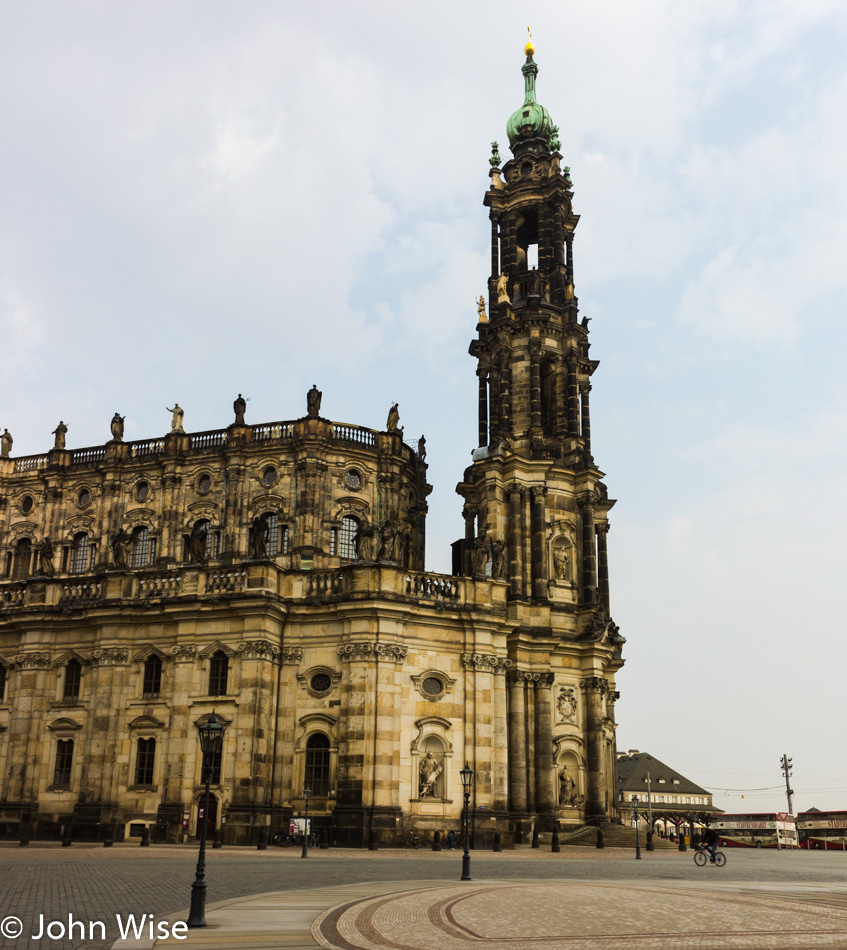
This is part of the Katholische Hofkirche or Dresden Cathedral but first, a detour to something that just caught my eye.

These are the guards of the Georges Gate or Georgentor. Early Techno Viking, if you ask me. This is on the Schlossplatz or Palace Square, which we are walking through to get to the Catholic Church.

The Dresden Cathedral is not a very ostentatious affair.

Sadly, we didn’t visit the crypt. We didn’t know at the time that the majority of the Wettin family is buried here along with the heart of King Augustus II, also known as Frederick Augustus I the Elector of Saxony, also popularly known as Augustus the Strong, also known as the Imperial Vicar and elected King of Poland, also known as the Grand Duke of Lithuania but even with all those titles he never had a sausage or sandwich named after him. Then again, the 4th Earl of Sandwich is buried in some rinky-dink place in a corner of England nobody has ever heard of, while King Augustus has his heart buried in a Cathedral, and his body rests in Wawel Cathedral in Kraków, Poland.

One of the towers of Dresden Castle. Our visit doesn’t include a tour of the museum, as this mini-four-day excursion is all about quantity equaling quality and not lingering for the sake of luxury. We are happy with this overall impression of the city instead of immersion. I should also admit that I have a bit of reluctance even being in Dresden as after reunification in 1990, right-wing extremists from Rostock, Halle, Magdeburg, and Dresden were creating disturbances that made me leery of ever visiting these places. As I walk through Dresden, I can’t help but be aware that I’m an American and that, for some people who live here, that is as bad as being from any of the other countries they loathe.

The Semperoper on Theaterplatz is an opera house Caroline and I would love to visit one day. As I’m writing this, all opera houses around the earth are closed to visitors due to the Covid-19 pandemic. Even putting on events that can be live-streamed is impossible as the crowding of the stage and orchestra pit would create precarious situations for the health of the actors and musicians.

I can’t decide which way we should go, so after looking at the opera, we turned our attention back to the Dresden Castle before finally moving over the grounds of the Zwinger.

Augustus the Strong needed a park with fountains to hang out in back in the day of managing so much land and carrying so many titles, so he built the Zwinger. Not all of it, as he ran out of money before he could realize all of his dreams, but lucky for us, at some point, the area was turned into gardens and a museum.

Following the bombing of Dresden during World War II, everything was touched in this city by destruction; nothing was left unscathed. Visiting Dresden today, you’d never know that nearly 70 years ago, this city could have been scrapped it was in such bad shape. The attention to detail and effort to spend the money required to put not just Dresden back together but every major German city across the landscape attest to what an effort can be made to modernize a country.

Who doesn’t love Baroque architecture? I could have lingered all day, but this wasn’t that kind of trip.

Earlier, we walked past the Fürstenzug, a.k.a. Procession of Princes; this is the other side and part of the old stable connected to Dresden Castle. In the background, you can see the steeple of the Cathedral, which might make you wonder why there’s a Catholic church in a Protestant city. Back in the day, when France was the seat of culture and intellect, the French royalty remained steadfast in their Catholicism, and so did those who needed to be close to power. While the Frauenkirche was under construction, the need to have a place of worship for the Catholics was also recognized and so Augustus III commissioned this Cathedral that was connected directly to his home.

Speaking of the Frauenkirche, here we are in its magnificent interior. This photo does no justice to the spectacular detail and beauty found in this church. It really is something one should see with their own eyes. By the way, notice the organ pipes? Those really are above the altar, which I’m trying to remember if I’ve ever seen this orientation in quite the same way as my memory says the organ is always over the entry in the back of the church. Another thing about the altar: imagine a peasant stepping up to the altar to receive the Eucharist; how would they not have felt they were in the presence of God himself, when in their normal lives, things may have been a grim struggle?

Nothing like a bunch of white and gold with chambers within chambers to draw the mind’s eye above into bright, lofty thoughts.

For those who might be inclined, and let me say I was surprised there were so few of us, you can make your way up the dome on this ramp, and while the view into the church itself is a bit cramped, you will be rewarded when you reach close to the top with the opportunity to step outside and see the next photo.

That is the River Elbe in front of us, as seen from the Frauenkirche here in Dresden, Germany. This was also the end of our time in this city as we’d decided to head over to Poland as neither of us had ever been there.

So much for getting over to Poland, as we are sidetracked in Bautzen. When in America, one doesn’t just stumble across Washington D.C., New York City, or Chicago to be drawn in by the skyline, and when driving past Scottsbluff, Nebraska, or Ardmore, Oklahoma, it isn’t likely that storage units will capture your curiosity, but as you approach a village in Europe, there’s too often something or other on the horizon that begs you to detour and come see what’s what. Just Google “Skyline Bautzen,” and you’ll see what I mean.
After parking near the Cathedral of St. Peter, as everyone knows that the cathedrals represent the center of the old town, we had to step inside.

Echoes of prayer and song with organ and choir can be heard between the shadows as the sun falls into the nave warming the memories of the parishioners who have once sat upon these pews.

The reward for being flexible is finding the opportunity to be delighted. I’d imagine that to the people that live on this street, there’s nothing special about this particular street, but to my American eyes, the yellow and red paint, the wrought iron lights, the curve in the street paved with stones, and a sidewalk cut of a different color stone are all notable qualities when contrasted with the country I’m from where asphalt and cement pave our paths and houses are mostly generic affairs built to last maybe 50 years, not 500 years.

Small corners with gated passages to places I won’t have the chance to visit create mystery as I try to imagine what is further up the stairs.

These are the ruins of the St. Nicholas Church. That’s right, Saint Nicholas, who some people know as Santa Claus. Just who was this Santa Claus guy who was originally known as Nicholas from Patara? Patara is now known as Demre in Turkey, but around 300 years after Christ, the town was Greek. The story goes that under the Roman Emperor Diocletian, who was busy prosecuting Christians, Bishop Nicholas fell into the clutches of prison, and upon being released, he attended the Council of Nicaea in A.D. 325, which your memory might serve you that this event was the First Ecumenical Council calling to preserve the unity of the church that was being threatened by various claims about the nature of Jesus Christ.
Eighteen years later, on 6 December 343, Nicholas died and turned into “manna,” or pure water, which proved he was a saint, but that wasn’t all. Stories came to life about the spirit of Nicholas being the protector of children and helper of those in need. Like all good tales, one thing leads to another, and pretty soon, you have a fat bearded white guy from the North Pole working with elves to bring loot on the 25th of December. WTF? A Greek Bishop under Roman dominion living on the coast of the Mediterranean hooks up with shape-shifting characters out of Norse mythology to raid electronics manufacturers in order to give children Playstations. Yeah, that’s the kind of people we are. But wait, we’re not done yet. Fast forward 1,100 years to 1450, and some people in the Sorbian village of Bautzen built a temple in honor of Santa Claus who had lived 1,800 miles south in Asia Minor because why? Well, that’s obvious: they were poor people who needed help, except then in 1619, with World War Zero raging (30 Years War, 1618-48), the church was razed, never to be rebuilt, because who needs a church dedicated to a myth that didn’t help anyone in Bautzen?

The astute reader picked up on me dropping “Sorbian village” into the conversation. I, too, wondered after Caroline and I arrived in Bautzen, “What is this Sorbian thing? I thought this was Germany?” Nothing is ever that easy in Germany, especially when it comes to how the country took shape, how language works here, and bread recipes. Without getting too deep into this ridiculously long blog entry that has 50 photos and a ton of words that I’m certain most people won’t even skim as they glide down the photos, thinking, why is this person wasting so much bandwidth on all these pictures that have meaning to me and just why did Google even suggest this page for what I was looking for? Anyway, the Sorbs are the people who gave themselves that name as they were ethnically Lusatians and Wends, not Germans. This West Slavic group is closer in identity to the Polish, Kashubian, Czech, and Slovak people, and while the Sorbian language is now a minority language in Germany, it’s still alive, such as right here in Bautzen.

I probably should have broken some of those paragraphs I’ve already written into smaller ones so I’d have something meaningful, historic, and important here, but I’ve got nothing. I did like the curve of the street, the wall, and how the house curves around the corner, I thought this was really cool. About the house on the right, does anyone else see the eyes on the roof and a mouth where the balcony should be?

I thought about removing this photo, though originally I liked it enough to have included it, but if I remove it, I have to go back and change where I wrote about this entry having 50 photos.

Sexy King Frog and his golden sphere must be some kind of Sorbian folktale, or maybe it was just part of a shop’s signage.
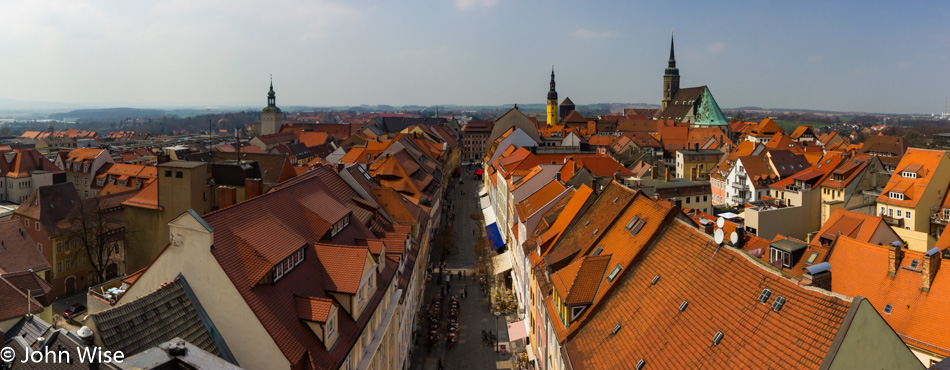
We just earned serious bragging rights as there are many people who can claim to have visited the Leaning Tower of Pisa but few who can say they’ve climbed to the top of the Leaning Tower of Bautzen, a.k.a. Reichenturm? But we did. The tower on the right is the Cathedral St. Peter, and off to its right and out of sight is the St. Nicholas Church. Straight ahead and a bit to the right with the yellow and black tower, that’s City Hall and near where we parked.

This mustard yellow City Hall building might be the appropriate color as it turns out that Bautzen is famous for its mustard. I wish I’d known this when we were there. But hey, it’s 2020, and Amazon has everything, right? Sure enough, they sell Bautz’ner Senf (mustard) right here in America, and I just got my order in. Time to continue our trek to Poland.
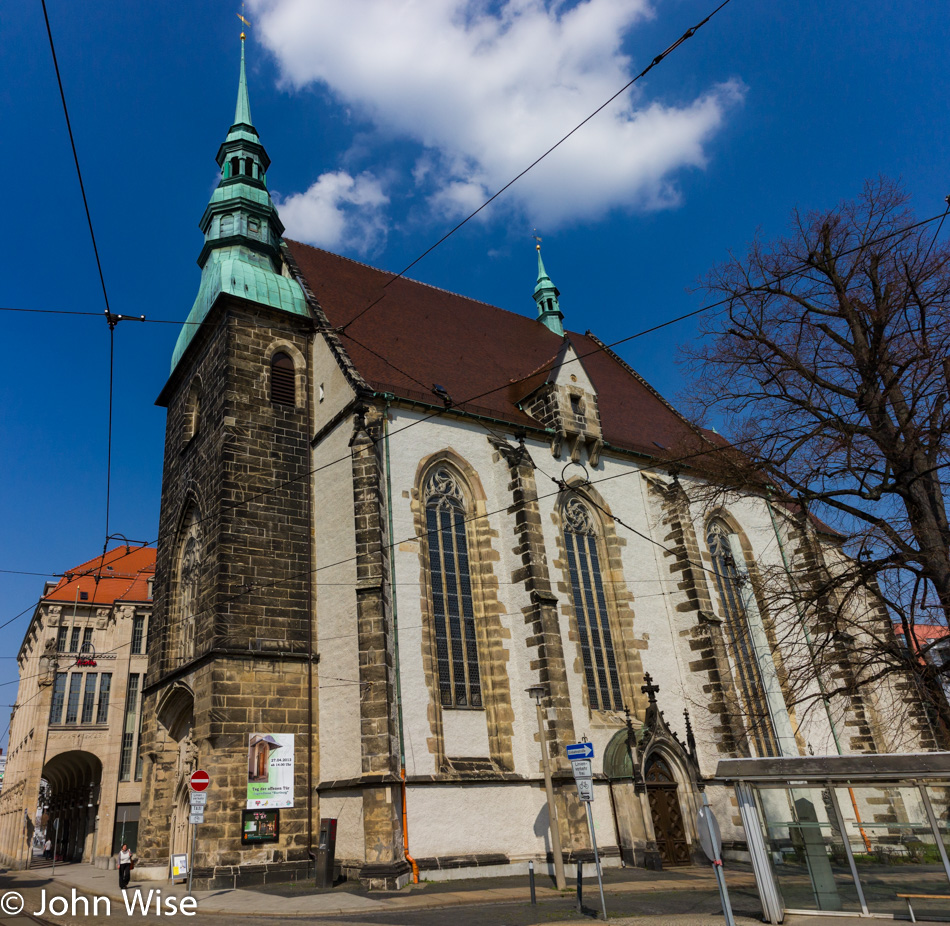
We thought we were going to Poland, but then the town on the border jumped into view. Welcome to Görlitz. This is the Frauenkirche, which you learned earlier in Dresden translates to Church of Our Lady. Just as the building is simple on the outside, so it is on the inside too. Had I shot at least one nice photo, I might have shared it but 50 photos are already so many. I think I’ve become my grandfather with his slideshows from his own travels at home back in the late 60s and early 70s.

If it’s called Dicker Turm, I’m going because a part of me is still 14 years old. Dicker Turm translates to Fat Tower, not Giant Penis. We should have gone up the 700-year-old 180 steps for a look around Görlitz and maybe even into Poland, but we were pressed for time on another side, too; Caroline is supposed to be getting some work done. This month in Germany began due to Jutta (my mother-in-law) breaking her hip. Part of the reason for so much time being able to be spent here is that Caroline could work remotely, and she still needs to get to that.

Oh damn, another church. We are suckers for churches and cannot turn away from one when we spot one. Just a quick look, we say, and then we find ourselves lost for even more time. This particular church is the Dreifaltigkeitskirche or Holy Trinity Church.
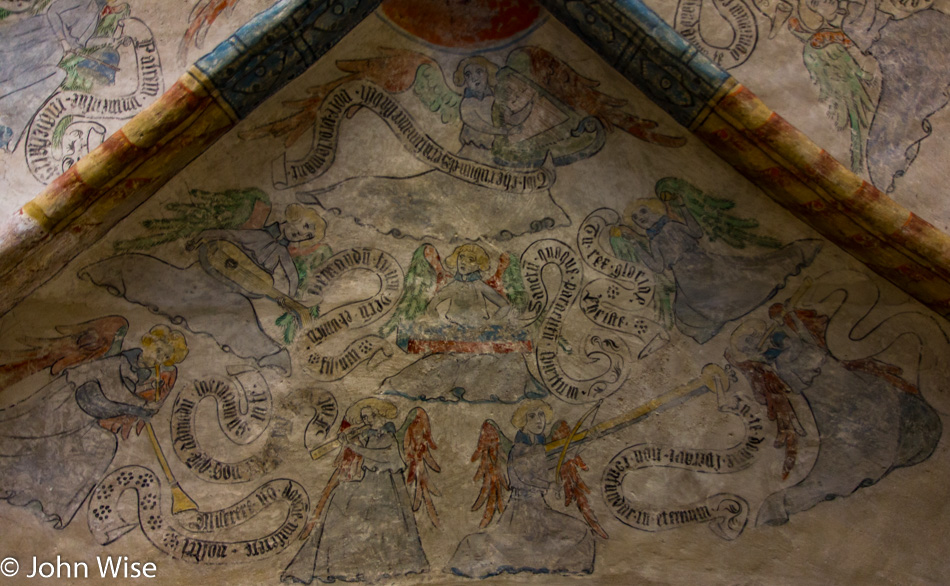
Older than the Fat Tower, this church was built between 1234 and 1245.

The altar in this church is spectacular, and because this overview lacks so much detail, I’m posting a closeup of the top of the altarpiece below.

I should have had my 70-200mm lens with me to capture the wings of the babies, but sometimes, when traveling, we have to opt for convenience over perfection.

Georgsbrunnen, or Fountain of St. George in the Altstadt, was just a momentary stop on our way through the “Old Town” doing some window shopping. Maybe we’d find a yarn store?
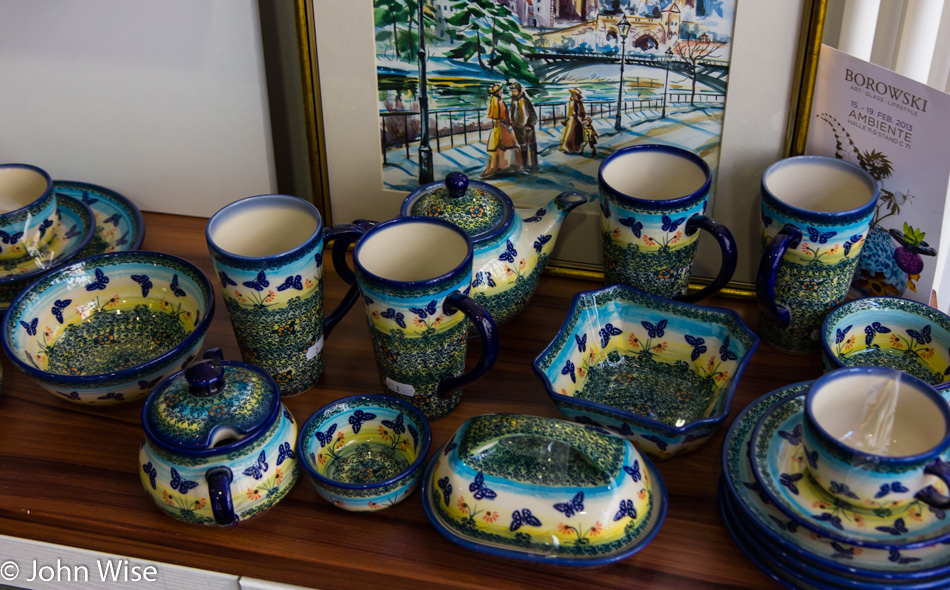
No yarn store but a gift store featuring Polish pottery from Bolesławiec. We left with a bowl that Caroline uses at least a couple of times a week. One of our favorite souvenirs ever.

We’re not the only ones to love the vibe here in Görlitz, as Wes Anderson was just here last month filming his new movie The Grand Budapest Hotel.

What is it about the quietest streets that hold some of the most appeal? I think that without people, I can imagine exactly what the place looked and felt like a couple of hundred years ago.

With the Trabi on the road, I can almost picture it being 1967 in the Deutsche Democratic Republic. Here’s the famous Trabant 601 stinking up the street.

God rays, how appropriate just before entering another church.
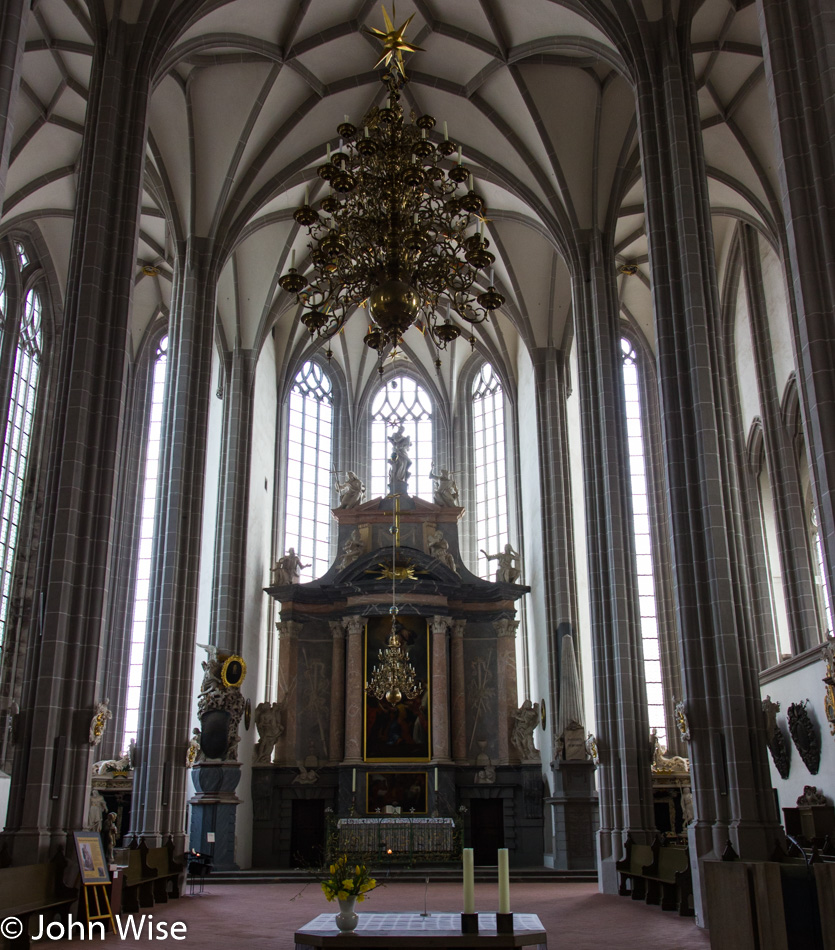
This is the Sts. Peter and Paul Church, and due to our free time winding down, we must run after the briefest of visits.

We are looking for Germany into Poland.

Little did we know it when I snapped this photo, but this is Piwnica Staromiejska, which is a restaurant on the Lusatian Neisse River. That’s right, earlier in Bautzen, we had just learned about Sorbians and their background, and here’s the river that separates Poland and Germany, and it’s called the Lusatian Neisse.

Needed the obligatory selfie in front of the Poland border marker, as one never knows if we’ll be out this way again. Poked around a little bit, but this side of the river didn’t look like a lot of history was on display, as maybe this was the old suburbs of the town center. Long ago, the two sides of the river were the same town, but as war and new state lines created divisions, the Polish side was named Zgorzelec.

Walking by the tower while we were on the bridge we saw that Piwnica Staromiejska had a sign out showing food and drink are available. This would be perfect for us to sit down for me to write a while and for Caroline to get caught up on work. It was a bit later in the day but still a good time for a late lunch, so we ordered a beer for Caroline, but our server interpreted it as a beer for each of us. I don’t drink, and we didn’t want to send it back as I insisted on ordering in my poor German instead of letting Caroline order, so Caroline had two beers while she worked. After a short wait, our food arrived: a shared plate of bacon and boiled potatoes with some carrot and cabbage salad.

Always room for a dessert especially something with orange and almond. We shared both dishes to ensure we’d have some appetite later when we found a hotel.

We are passing through Ostritz, Germany, on our way towards Czechia, also referred to as the Czech Republic. Where Bautzen and Görlitz have obviously benefited from reconstruction Euros, Ostritz has been left in the dark and is decaying.

Not to say there’s not a lot of character here and maybe someday others will move in to start renovations.

Five years after our visit, Ostritz gained international attention when it hosted a Neo-Nazi music festival. I’d guess they did so in order to bring some money into town, and who knows, maybe the old inhabitants miss the days of oppression, dictators, national socialism, or communism. Luckily for us, we didn’t run into a single skinhead.

After leaving Ostritz, it was only another 20km to Zittau, and while we would have liked to drive all the way to Prague tonight, we weren’t sure about language problems, finding inexpensive lodging, or even navigating Czechia’s roads. While we found a room at the Black Bear Hotel (Schwarzer Bär), there weren’t a lot of dinner options, so we dined at the hotel’s restaurant. Dinner was okay, but breakfast the next day was where the wow factor came in. Two days into our little road trip and it already feels like we’ve been out for a week or two.